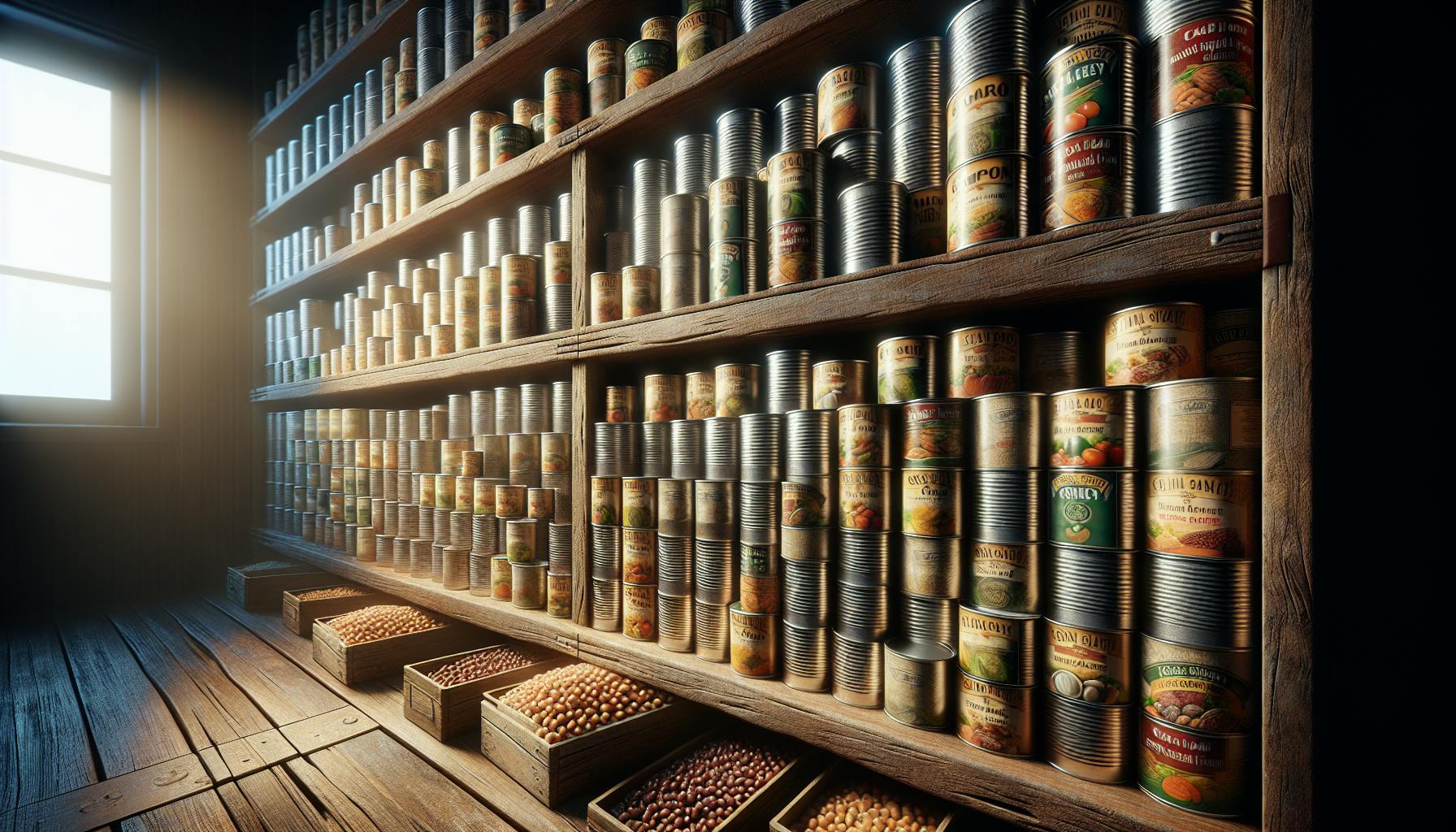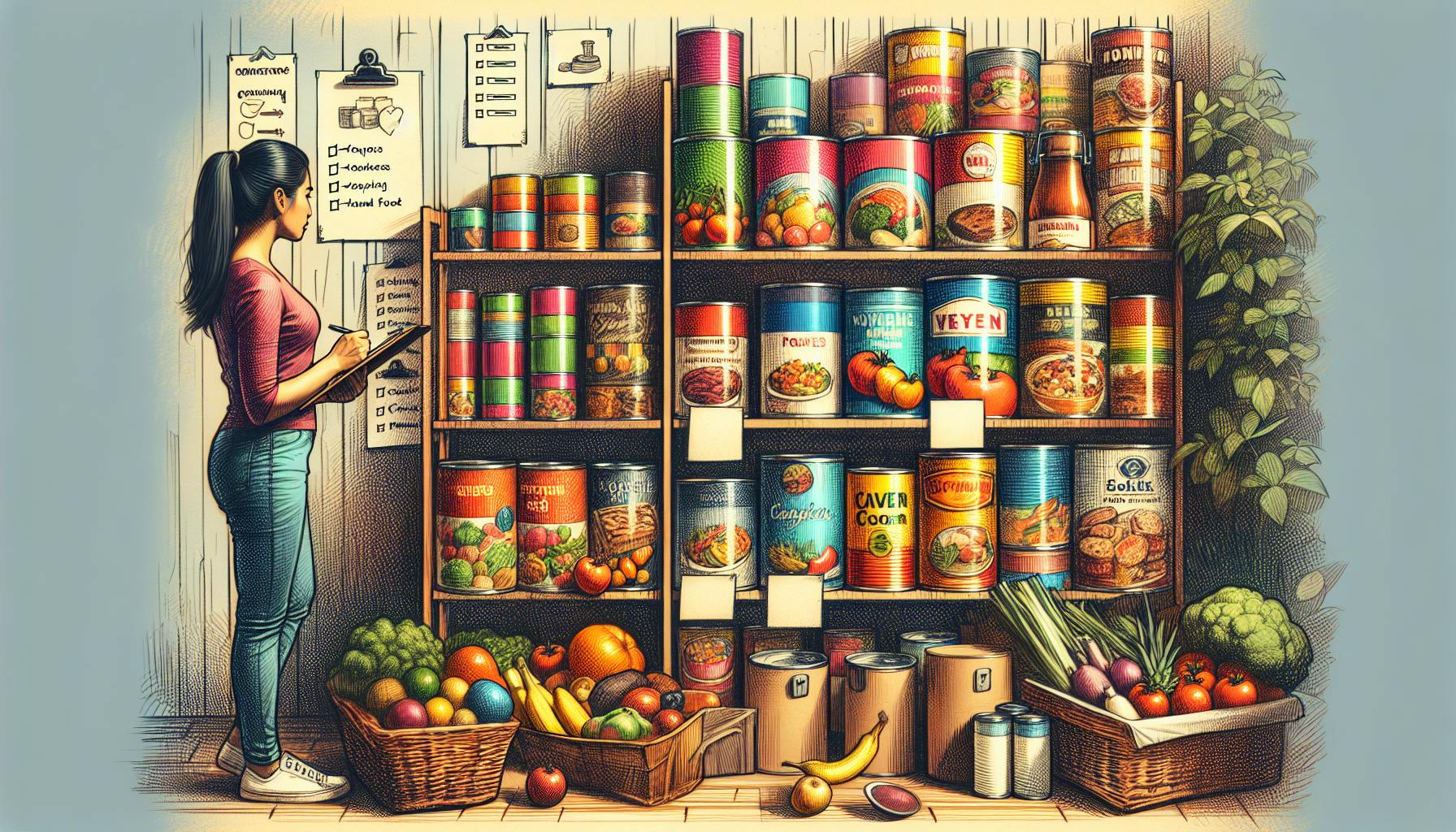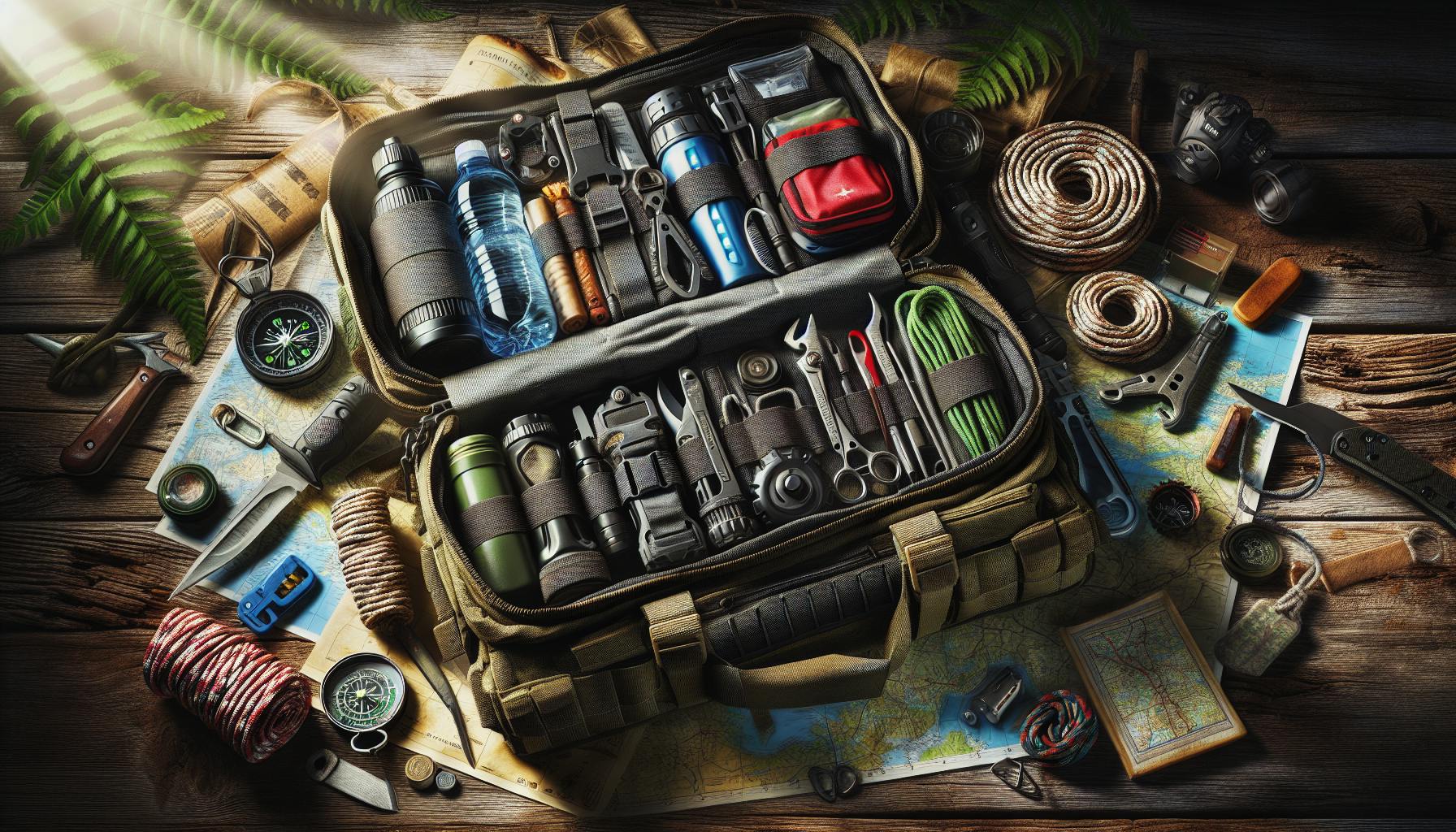Finding reliable information on stocking up on non-perishable foods can be challenging.
This article provides a comprehensive guide to choosing nutritious foods with long shelf lives to include in an emergency pantry.
You'll discover a list of the best long-lasting foods to store, like grains, legumes, preserved meats, and honey, along with tips for maximizing shelf life through proper storage. You'll also learn how to combine these foods into nutritious, easy-to-prepare meals.
Introduction to Long Shelf Life Foods
This introductory section provides an overview of long shelf life foods, defining what they are and explaining why they are essential for emergency preparedness. It highlights the benefits of stocking up on non-perishable foods with long shelf lives.
Understanding the Importance of Long Shelf Life Foods for Emergencies
Having a supply of long shelf life foods is critical for emergency preparedness. These non-perishable foods can be stored for extended periods of time without refrigeration, ensuring you have reliable access to nutrition if the power goes out or you need to evacuate quickly. Building an emergency food pantry with items that have shelf lives of multiple years allows you to be prepared for any situation from natural disasters to civil unrest.
Some top reasons long shelf life foods are vital for emergency supply kits:
- Provide food security if stores close or supply chains are disrupted
- Offer lightweight, nutritious options if evacuation is needed
- Eliminate reliance on electricity for refrigeration
- Save money compared to frequently replacing perishable goods
- Give peace of mind knowing your family won't go hungry
Advantages of Cheap Food with Long Shelf Life
Prioritizing cheap food with long shelf life when prepping your emergency pantry allows you to affordably stock up on non-perishables. With shelf-stable staples like beans, rice, pasta, and canned vegetables, you can build substantial food reserves without breaking the bank. This makes survival preparedness achievable even on a tight budget.
Other money-saving benefits of long shelf life food include:
- Buy in bulk and store for later without spoilage concerns
- Take advantage of sales, coupons, and bulk discounts
- No need to frequently replace perishable goods
- Avoid impulse purchases and last-minute runs to the grocery store
The USDA's Role in Food Longevity Information
The USDA provides resources like their food storage database and FoodKeeper App to educate consumers on the shelf life and nutritional value of different foods. This helps us understand how long our emergency food supplies will last and how to preserve nutrition. Their research on food safety and longevity makes it easier to confidently stock up on long shelf life items.
Key info provided by the USDA includes:
- Expected shelf life of various foods properly stored
- Changes in nutritional composition over time
- Proper storage methods to maximize freshness
- Signs of spoilage to look out for
Their food longevity resources help us build well-informed emergency pantries.
What food has longest shelf life?
Some foods can last for years or even decades if stored properly. Here are some of the foods with the longest shelf lives:
Canned Goods
Canned goods like beans, soups, vegetables, and fruits can often last 2-5 years unopened. The canning process kills bacteria and seals out new contaminants. As long as the can remains intact, the food inside should be safe to eat. Just check for dents, rust, or swelling before opening.
Honey
Because of its acidic pH and low moisture content, honey can last indefinitely unopened. Even if it crystallizes, honey is still good. Simply place the jar in warm water to reliquify it.
Rice
White, wild, jasmine, and basmati rice can last 30 years or more if stored in an airtight container in a cool, dry place. The exception is brown rice, which has higher oil content and will only last around 6 months.
Dried Beans
Like rice, dried beans can have a shelf life of 30+ years when properly stored. Make sure they stay cool and dry. Rehydrate before cooking them.
Pure Maple Syrup
Real maple syrup keeps its quality and flavor for over a year sealed in the fridge. Its high sugar concentration prevents microbial growth.
Soy Sauce
Unopened and stored at room temperature, soy sauce can last at least 3 years thanks to its saltiness. Refrigeration can extend its shelf life further.
The key is keeping food sealed and stored appropriately to prevent spoilage. Also, pay attention to best-by dates for maximum freshness and flavor.
What foods should I stockpile for survival?
When building your survival food pantry, focus on shelf-stable items that are nutrient-dense and will last a long time without refrigeration. Some essentials to stock up on include:
- Canned and dried meats: Canned varieties of meat, poultry, fish, and beans are survival pantry staples. Opt for low-sodium versions packed in water when possible. Dried meats like beef jerky also have an incredibly long shelf life.
- Canned fruits and vegetables: Fruits and veggies packed in their own juices or water provide key micronutrients. Go for a variety - mixed veggies, greens like spinach, and vitamin-C rich options like tomatoes.
- Grains: Whole grains like oats, barley, quinoa, and brown rice store well. Plus, products like cereal, crackers, and shelf-stable bread provide carbs.
- Shelf-stable dairy: Powdered milk, canned evaporated milk, and milk alternatives like shelf-stable almond milk check the dairy box.
- Oils and fats: Coconut oil, olive oil, nuts, seeds, and nut butters supply healthy fats with longevity.
When stocking up on survival foods, prioritize nutrient density, caloric value, and shelf life. Store items properly to maximize freshness. With the right long-lasting foods, you can be eating well no matter the situation.
What is the best food for long term storage?
Rice and beans are nutritious, affordable, and have an extremely long shelf life, making them ideal for long term food storage. White rice can be stored for 30 years if kept dry and cool. Dried beans can last up to 10 years when properly stored.
Other good options include:
- Ready-to-eat cereals (up to 1 year shelf life)
- Pasta and pasta mixes (1-2 years)
- Dried fruits and vegetables (6 months to 1 year)
- Canned meats, fruits, vegetables (2-5 years)
- Honey (indefinite shelf life)
When stocking your survival pantry, prioritize nutrient-dense, non-perishable foods that are:
- High in fiber, protein, and healthy fats
- Packed with vitamins and minerals
- Easy to prepare with minimal ingredients/cooking
- Affordable and easy to obtain
Properly storing foods can help preserve freshness and nutritional value. Keep items in a cool, dark place and check expiration dates regularly. Rotating stock by using first-in-first-out methods also helps. With the right foods and proper storage, you can be prepared for any emergency situation.
What foods have 5 year shelf life?
According to the FSIS, canned foods with a low acid content, like meat, beans, peas, soups, or vegetables (or our favorite, canned tuna), will keep anywhere from two to five years. High-acid canned goods like tomato sauce and canned fruit will keep up to 18 months.
Some examples of low-acid canned foods that can last 5 years or more include:
- Canned meats like tuna, chicken, salmon
- Canned beans, lentils, chickpeas
- Canned soups and stews
- Canned vegetables like carrots, green beans, corn
- Canned fruits like pineapples, pears, peaches
When properly stored in a cool, dark place, these canned goods can maintain quality and safety for several years past their 'best by' date. Over time, the texture and flavor may degrade slightly but they will still be edible.
The key is ensuring the cans remain intact with no dents, rust, or swelling which could indicate spoilage. As long as the can is still sealed and intact, the food inside should be safe to eat for 5+ years. However, always inspect carefully and use common sense before consuming very old canned goods.
For the longest shelf life, buy canned goods with later 'best by' dates and rotate stock using a first-in-first-out system. Track dates with a marker to ensure older cans get used first. With some care and planning, stockpiling canned goods can be a safe and effective way to build up a long-term emergency food supply.
sbb-itb-b932644
Essential Long Shelf Life Foods List
This section will enumerate the best long-term food storage options, creating a comprehensive long shelf life foods list suitable for any survival pantry.
Grains and Legumes: Fibrous Whole Grain and High-Protein Staples
Grains and legumes like rice, beans, lentils, and quinoa are fibrous whole grains that provide a healthy dose of protein and fat to support your digestion and gut health. Brown rice, for example, has a shelf life of 1-2 years when properly stored, while dried beans and lentils can last up to 10 years. These staples offer a small boost of fiber as well. Stock up on these high-protein, nutritious foods for your long term food storage.
High Calorie Long Shelf Life Foods for Energy
Look to nutrient-dense foods like nuts, nut butters, and dried fruits for a substantial energy boost with a long shelf life. Almonds and peanut butter can last up to 12 months stored properly, providing healthy fats and protein. Dried fruits like raisins, cranberries, and apricots are tasty, cheap foods with long shelf life that provide quick calories. These high-calorie foods will fuel your body in an emergency.
Preserved and Dried Proteins: A Source of Complete Protein
Canned and dried meats make excellent additions to your survival pantry for lasting sources of complete protein. Canned tuna, salmon, chicken, and spam can have shelf lives of 2-5 years. Beef and turkey jerky or pemmican, a mix of dried meat and fat, are complete proteins that can last up to 15 years when stored properly. Stock up on these preserved and dried proteins.
The Immortality of Honey: How Honey Will Remain Safe to Eat
Honey is considered one of the most shelf-stable foods, with an indefinite shelf life. Due to its low moisture content and antibacterial properties, the USDA states that most shelf-stable foods like honey will be safe indefinitely when stored properly. Keep honey away from moisture and pests to enjoy its sweetness for decades. It’s a versatile survival food that will remain safe to eat even after years of storage.
Maximizing the Shelf Life of Your Survival Pantry
This section will delve into the best practices for food storage to extend the longevity of survival foods with long shelf life.
Effective Food Storage and Kitchen Organization
Properly organizing your pantry is key to protecting your long shelf life foods from pests and ensuring you can easily access and rotate them. Here are some tips:
- Store foods in airtight, food-grade plastic containers or Mylar bags. This protects against insects, rodents, and moisture.
- Label containers with the contents and date. Use oldest food first with a "first in, first out" system.
- Keep storage area clean, cool, and dry. Temperature control is key (more below).
- Shelve foods so you can easily take inventory and access items. Group like items together.
- Consider installing shelves and organizing bins to maximize vertical space.
The Role of the USDA's Food Safety and Inspection Service (FSIS)
The USDA's FSIS provides guidelines on food safety, including identifying spoiled foods. Their resources help determine the number of foods that don't really go bad for ages when properly stored.
Specifically, FSIS advises checking for:
- Changes in color, texture, or odor
- Mold growth
- Insect infestation
- Bulging cans or jar lids
Discard foods showing these signs of spoilage. Properly stored long shelf life foods should remain safe indefinitely.
Temperature Control and Humidity Management
Storing foods at the proper temperature preserves freshness and shelf life. General guidelines:
- Dry goods like grains: 50-70°F
- Canned goods: 50-70°F
- Refrigerated goods: 35-40°F
- Frozen goods: 0°F
Monitor humidity as well. Excess moisture can cause mold growth. Use a dehumidifier if humidity exceeds 70%.
Following these best practices will ensure you get the maximum shelf life out of your long shelf life foods stockpile.
Creating Nutritious Meals with Foods That Last a Long Time Without Refrigeration
This section provides practical tips for making nutritious meals from pantry staples with long shelf lives. The focus is on combining ingredients for nutritional balance and making quick, appetizing snacks and meals.
Combining Foods for Nutritional Balance: Fiber, Protein, and Healthy Fats
When creating meals with long shelf life foods, aim for nutritional balance by mixing ingredients high in fiber, protein, and healthy fats:
- Combine fibrous whole grains like brown rice or oats with beans, lentils, or canned fish for a complete protein. The fiber aids digestion while the protein provides lasting energy.
- Trail mixes with nuts, seeds, and dried fruit offer fiber, protein, and healthy fats for an energizing snack. Almonds and walnuts also provide heart-healthy fats.
- Mix peanut or other nut butters with oats, whole grain crackers, apples, or celery for quick high-protein snacks and meals. Nut butters offer healthy fats that keep you feeling full.
Quick and Easy Long Shelf Life Snacks
Assembling snacks from your long term food storage pantry can take just minutes:
- Apples or other fresh fruit paired with nut butters or trail mix makes a tasty snack full of fiber and protein.
- Whole grain crackers topped with canned fish, nut butter, or bean dip provide a small boost of fiber plus a healthy dose of protein and fat.
- Dried fruit and nut mixes offer fiber, vitamins, minerals, and healthy fats for an energizing snack anywhere.
Food Pairings for Maximum Nutrient Absorption
Combine certain ingredients to maximize the nutritional value of foods with long shelf lives:
- Eat citrus fruits or tomatoes with iron-rich beans, lentils, canned fish or meat to enhance iron absorption. The vitamin C boosts the bioavailability of plant and animal-based iron sources.
- Add herbs and spices like turmeric, cinnamon, or oregano to enhance flavor and the antioxidant value of ancient grains, beans, lentils, and more.
With some creativity and knowledge of food pairing fundamentals, you can make tasty, nutritionally balanced meals from long shelf life ingredients alone!
Food that Lasts 25 Years: Building a Legacy Pantry
Discussing the concept of a legacy pantry filled with food that lasts 25 years, ensuring long-term food security and peace of mind.
Selecting Food with a Quarter-Century Lifespan
When building a long-term food storage pantry designed to last 25 years, focus on shelf-stable foods that have an exceptionally long shelf life without refrigeration. Some examples include:
- White rice: When stored properly in airtight containers, white rice can last 30 years or more. Brown rice has a shorter lifespan at only 6 months.
- Hardtack crackers: These ultra dry crackers can remain edible for decades when kept dry and sealed. They were a staple on old sailing voyages for this reason.
- Honey: With its low moisture content, honey essentially never goes bad. It may crystallize but remains safe to eat. There are reports of edible honey found in ancient Egyptian tombs!
- Dehydrated and freeze-dried fruits, vegetables, and meats: With almost all moisture removed, these foods can last 20-30 years in sealed containers. Great for nutrients and variety.
- Instant coffee: The instant coffee powder retains flavor for 30 years when kept dry and sealed. Add hot water for an instant cup of coffee decades later!
Investing in Your Future with Long-Term Food Storage
Stocking up on long shelf life foods is an investment in your future. Rather than worrying about short-term freshness, you can rest assured knowing you have food reserves to last decades. Some key benefits include:
- Financial savings: Buying bulk long-term storable foods can save up to 70% over grocery store prices. You hedge against food inflation over decades.
- Emergency preparedness: Be set for any personal or large-scale emergency disrupting normal food supply chains for weeks, months or years.
- Nutrition security: Get peace of mind knowing you and your family will remain well fed for generations to come, regardless of external events.
- Flavor and nutrition: With a well-planned long term pantry, you can enjoy tasty, nutritious meals with variety for 25 years, not just bland survival rations.
Legacy Pantry Maintenance and Rotation
To maximize shelf life, store long term food reserves properly by following this guidance:
- Keep food in a cool, dark place like a basement or cellar. Avoid temperature fluctuations.
- Use oxygen absorber packets and quality sealable containers to prevent moisture and oxygen exposure.
- Rotate stock using the "first in, first out" rule to use up older items first.
- Inspect containers periodically for signs of spoilage. Discard anything questionable.
- Consider setting reminder alerts to consume opened products within expected timespans.
With proper maintenance and rotation, a legacy food pantry can offer nutritious sustenance for decades to come. The investment offers priceless peace of mind.
Conclusion
Long shelf life foods are essential for emergency preparedness. Non-perishable foods with long shelf lives, such as whole grains, beans, nuts, and certain canned goods, provide nutrients and energy when access to fresh foods is limited.
Key reasons to stock up on long shelf life foods include:
- Reliability during emergencies when stores may be closed
- Reduced waste from spoilage
- Energy and nutrients from less-perishable whole food sources
- Lower cost to build up reserves over time
Helpful resources for stocking a survival pantry include:
- USDA FoodKeeper App - guidelines on storage times
- Bulk retailers for large quantity purchases
- Local food banks and community organizations
Building up a supply of non-perishable emergency foods can provide comfort and resilience for unpredictable events. Focus on nutrient-dense whole foods with established safety guidelines for your family's needs.


